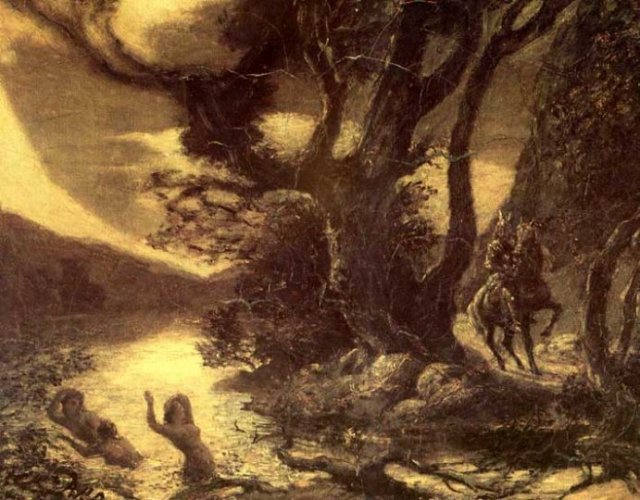Nibelungenlied
The Nibelungenlied (the "Song of the Nibelungs") was a heroic epic poem written in Middle High German, most likely in Austria, during the early 13th century. The Nibelungenlied was another version of the Nibelungen cycle that was different from the Icelandic works. It was the most popular epic written in medieval German, since half a dozen complete manuscripts have survived.
Like the Icelandic saga, the Nibelungenlied was a tale of the cycle of betrayal and revenge in the cursed Burgundian royal family.
There were other Nibelungen sagas from the Icelandic Völsunga Saga (Volsunga Saga), and the Norwegian Thidrekssaga or Thiðrekssaga ("Deeds of Thiðreks" (Dietrich)). Though all three sagas were written around the same century, their sources were much older, and some of the characters have connections with historical (or semi-historical) figures.
The Nibelungenlied (as well as Thiðrekssaga) belonged to the German tradition, and it did not only form part of the Nibelungen cycle, but also the Dietrich cycle, called the Dietrichsage.
Dietrich, or Thidreks in the Norwegian saga, was based on the historical figure of Theodoric the Great (AD 493-526), an Ostrogothic king of Italy. There are many other German tales of Dietrich, including Die Rabenschlacht ("The Battle of Ravenna"), Dietrichs Flucht ("Dietrich's Flight"), Walther and Hildegund, and Hildebrandslied.
Some modern scholars say that the Nibelungenlied was only surpassed by the Iliad, though I think that is debatable. Unlike the Volsunga Saga and other sources, the Nibelungenlied adopted a more contemporary setting, since the heroes and villains wore armour and assumed behaviours of the knights of the twelfth century. Also, most of the kingdoms found in the Nibelungenlied were predominantly Christian. Only Etzel (Atli or Attila), king of Hungary, was a heathen. Those characters found in the Volsunga Saga and the poems or dialogues found in the Poetic Edda believed in the Old Norse religion and gods, so the characters were definitely pagans. The norse gods appeared in the works of Volsunga Saga, especially Odin. The geography in the Nibelungenlied was also more precise than the Volsunga Saga.
I have written the Nibelungenlied mainly as a comparison to the Völsunga Saga.
I have divided the Nibelungenlied into two parts. The first part is concerned with the theme and climax of the death of the hero Siegfried. The second part ends with the theme/climax of Kriemhild's revenge on Hagen and her own death.

Well, I hope you enjoyed the Nibelungenlied, because last year, when I had completed the Volsunga Saga, I was not going to do the Nibelungenlied. Obviously, I have changed my mind again.
Genealogy
Related Pages
By Jimmy Joe






